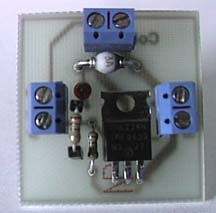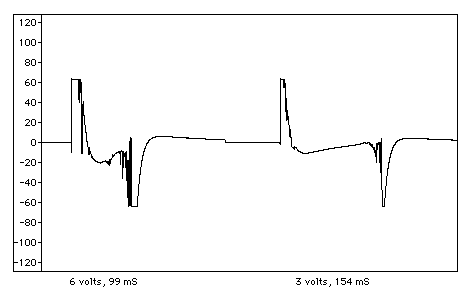Semiconductor switch for antique battery clocksI've been restoring an American Clock Company battery electric. It's the one with two weighted lever arms that drive the gear train. One arm and then the other are alternately "thrown up" by an electromagnet about every 8 minutes. In my clock, the switch that enables the magnet has corroded. Furthermore, the bottom contacts are damaged and they don't make reliable electrical contact for the "power pulse". I decided to add some silicon to my switch and improve it's performance. I decided to take the time to produce a convenient circuit that could be replicated for others. I fabricated a small circuit board (1.5" square) with all the necessary components to convert the clock switch into a low power "logic" switch. The power is delivered to the magnet coils with a transistor switch. A silicon diode is incorporated to quench the back emf, and I added an LED for visual confirmation that the switch has closed and the transistor has turned on.
After installing my semiconductor switch, the mechanical switch only passes a few milliamps so no spark develops, but full voltage and current is delivered to the coils. I can now run the clock on 6 volts (4 "D" cells) which ought to provide longer life because the drop out point will take longer to reach. The quit-witted may argue that this advantage will be lost because more current is consumed on each pulse. I counter with the observation that the power pulse has a shorter duration when the voltage is higher because more energy is delivered to the magnetic field. To confirm this I captured a 3 volt and a 6 volt impulse on a personal computer and plotted them out. The 3 volt pulse has a duration of about 155 milliseconds. The 6 volt impulse is just 100 mS.
The clock is now running again on the same "D" cells that stalled last week. If anyone has an interest in one of these circuits they are available for purchse. The power switch is a TO-220 MOSFET and will handle battery supplies between 3 and 30 volts and up to about 15 amps. It has 6 screw terminals on the board: 2 for the battery, 2 for the coil, and 2 for the switch. Installation is easy - just connect the 6 wires. Bryan Mumford
Note: We are not currently making the Semiconductor Switch. You can send us an email and we will notify you if they become available.
Home | Horology | MicroSet | Clock circuits Voltage regulators | SlaveDriver | Governor | Semiconductor switch | EM controller
|
 Previously I had determined that my clock ran fine on 3 to 6 volts, but 6 volts drew an unpleasant arc on the switch. I had hoped that modern alkaline "D" cells would provide adequate life since they have much improved chemistry over dry cells of the turn of the century. But I found my two "D" cells only lasted about 3 weeks. When the batteries got down to about 2.8 volts the clock would stall with the switch on (perhaps because of poor conductivity in the switch). Naturally, this was the end of the batteries.
Previously I had determined that my clock ran fine on 3 to 6 volts, but 6 volts drew an unpleasant arc on the switch. I had hoped that modern alkaline "D" cells would provide adequate life since they have much improved chemistry over dry cells of the turn of the century. But I found my two "D" cells only lasted about 3 weeks. When the batteries got down to about 2.8 volts the clock would stall with the switch on (perhaps because of poor conductivity in the switch). Naturally, this was the end of the batteries.
